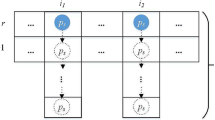Abstract
The XCS classifier system for sequence labeling (XCS-SL) is an extension of XCS for sequence labeling, a form of time-series classification where every input has a class label. In XCS-SL a classifier condition consists of some sub-conditions which refer back to previous inputs. Each sub-condition is a memory. A condition has n sub-conditions which represent an interval from the current time t0 to a previous time t_ n . A problem of this representation (called interval coding) is, even if only one input at t_ n is needed, the condition must consist of n subconditions to refer to it. We introduce a messy coding based condition where each sub-condition messily refers to a single previous time. Unlike the original coding, the set of sub-conditions does not necessarily represent an interval, so it can represent compact conditions. The original XCS-SL evolutionary mechanism cannot be used with messy coding and our main innovation is a novel evolutionary mechanism. Results on a benchmark show that, compared to the original interval coding, messy coding results in a smaller population size and does not require as high a population size limit. However, messy coding requires more training with a high population size limit. On a real world sequence labeling task messy coding evolved a solution that achieved higher accuracy with a smaller population size than the original interval coding
Access this chapter
Tax calculation will be finalised at checkout
Purchases are for personal use only
Preview
Unable to display preview. Download preview PDF.
Similar content being viewed by others
References
Butz, M.V., Wilson, S.W.: An Algorithmic Description of XCS. Journal of Soft Computing 6(3-4), 144–153 (2002)
Kaluža, B., Mirchevska, V., Dovgan, E., Luštrek, M., Gams, M.: An Agent-based Approach to Care in Independent Living. In: de Ruyter, B., Wichert, R., Keyson, D.V., Markopoulos, P., Streitz, N., Divitini, M., Georgantas, N., Mana Gomez, A. (eds.) AmI 2010. LNCS, vol. 6439, pp. 177–186. Springer, Heidelberg (2010)
Lafferty, J.D., McCallum, A., Pereira, F.C.N.: Conditional Random Fields: Probabilistic Models for Segmenting and Labeling Sequence Data. In: ICML 2001, pp. 282–289 (2001)
Lanzi, P.L., Wilson, S.W.: Toward Optimal Classifier System Performance in Non-Markov Environments. Evolutionary Computation 8(4), 393–418 (2000)
Lanzi, P.L.: Extending the Representation of Classifier Conditions Part I: From Binary to Messy Coding. In: GECCO 1999, pp. 337–344. Morgan Kaufmann (1999)
Nakata, M., Kovacs, T., Takadama, K.: A Modified XCS Classifier System for Sequence Labeling. In: Proc. of GECCO 2014, pp. 565–572. ACM (2014)
Ordóñez, F.J., de Toledo, P., Sanchis, A.: Activity Recognition Using Hybrid Generative/Discriminative Models on Home Environments Using Binary Sensors. Sensors 13(5), 5460–5477 (2013)
Schmid, H.: Probabilistic Part-of-Speech Tagging Using Decision Trees. In: International Conf. on New Methods in Language Processing, pp. 44–49 (1994)
Tomlinson, A., Bull, L.: An Accuracy Based Corporate Classifier System. Soft Computing 6(3-4), 200–215 (2002)
Wilson, S.W.: Classifier Fitness Based on Accuracy. Evolutionary Computation 3(2), 149–175 (1995)
Author information
Authors and Affiliations
Editor information
Editors and Affiliations
Rights and permissions
Copyright information
© 2014 Springer International Publishing Switzerland
About this paper
Cite this paper
Nakata, M., Kovacs, T., Takadama, K. (2014). Messy Coding in the XCS Classifier System for Sequence Labeling. In: Bartz-Beielstein, T., Branke, J., Filipič, B., Smith, J. (eds) Parallel Problem Solving from Nature – PPSN XIII. PPSN 2014. Lecture Notes in Computer Science, vol 8672. Springer, Cham. https://doi.org/10.1007/978-3-319-10762-2_19
Download citation
DOI: https://doi.org/10.1007/978-3-319-10762-2_19
Publisher Name: Springer, Cham
Print ISBN: 978-3-319-10761-5
Online ISBN: 978-3-319-10762-2
eBook Packages: Computer ScienceComputer Science (R0)




